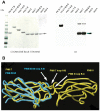Alternative splicing of the angiogenesis associated extra-domain B of fibronectin regulates the accessibility of the B-C loop of the type III repeat 8
- PMID: 20161770
- PMCID: PMC2818841
- DOI: 10.1371/journal.pone.0009145
Alternative splicing of the angiogenesis associated extra-domain B of fibronectin regulates the accessibility of the B-C loop of the type III repeat 8
Abstract
Background: Fibronectin (FN) is a multi-domain molecule involved in many cellular processes, including tissue repair, embryogenesis, blood clotting, and cell migration/adhesion. The biological activities of FN are mediated by exposed loops located mainly at the interdomain interfaces that interact with various molecules such as, but not only, integrins. Different FN isoforms arise from the alternative splicing of the pre-mRNA. In malignancies, the splicing pattern of FN pre-mRNA is altered; in particular, the FN isoform containing the extra-domain B (ED-B), a complete FN type III repeat constituted by 91 residues, is undetectable in normal adult tissues, but exhibits a much greater expression in fetal and tumor tissues, and is accumulated around neovasculature during angiogenic processes, thus making ED-B one of the best markers and targets of angiogenesis. The functions of ED-B are still unclear; however, it has been postulated that the insertion of an extra-domain such as ED-B modifies the domain-domain interface and may unmask loops that are otherwise cryptic, thus giving FN new potential activities.
Methodology: We used the mAb C6, which reacts with ED-B containing FN, but not with ED-B-free FN and various recombinant FN fragments containing mutations, to precisely localize the epitopes recognized by the mAb C6.
Conclusion: We formally demonstrated that the inclusion of the alternatively spliced angiogenesis-associated ED-B leads to the unmasking of the FNIII 8 B-C loop that is cryptic in FN molecules lacking ED-B. Thus, the mAb C6, in addition to providing a new reagent for angiogenesis targeting, represents a new tool for the study of the potential biological functions of the B-C loop of the repeat FNIII 8 that is unmasked during angiogenic processes.
Conflict of interest statement
Figures


Similar articles
-
C6: A Monoclonal Antibody Specific for a Fibronectin Epitope Situated at the Interface between the Oncofoetal Extra-Domain B and the Repeat III8.PLoS One. 2016 Feb 11;11(2):e0148103. doi: 10.1371/journal.pone.0148103. eCollection 2016. PLoS One. 2016. PMID: 26867013 Free PMC article.
-
NMR structure of the human oncofoetal fibronectin ED-B domain, a specific marker for angiogenesis.Structure. 1999 Apr 15;7(4):381-90. doi: 10.1016/s0969-2126(99)80051-3. Structure. 1999. PMID: 10196121
-
The inclusion of the type III repeat ED-B in the fibronectin molecule generates conformational modifications that unmask a cryptic sequence.J Biol Chem. 1992 Dec 5;267(34):24689-92. J Biol Chem. 1992. PMID: 1280266
-
99mTc-Anti-ED-B fibronectin single-chain antibody fragment L19-His.2007 Feb 12 [updated 2008 Jan 16]. In: Molecular Imaging and Contrast Agent Database (MICAD) [Internet]. Bethesda (MD): National Center for Biotechnology Information (US); 2004–2013. 2007 Feb 12 [updated 2008 Jan 16]. In: Molecular Imaging and Contrast Agent Database (MICAD) [Internet]. Bethesda (MD): National Center for Biotechnology Information (US); 2004–2013. PMID: 20641593 Free Books & Documents. Review.
-
99mTc-Anti-ED-B fibronectin L19-(Gy)3-Cys-Ala scFv antibody fragment.2007 Feb 6 [updated 2008 Jan 14]. In: Molecular Imaging and Contrast Agent Database (MICAD) [Internet]. Bethesda (MD): National Center for Biotechnology Information (US); 2004–2013. 2007 Feb 6 [updated 2008 Jan 14]. In: Molecular Imaging and Contrast Agent Database (MICAD) [Internet]. Bethesda (MD): National Center for Biotechnology Information (US); 2004–2013. PMID: 20641676 Free Books & Documents. Review.
Cited by
-
Plasma and cellular fibronectin: distinct and independent functions during tissue repair.Fibrogenesis Tissue Repair. 2011 Sep 16;4:21. doi: 10.1186/1755-1536-4-21. Fibrogenesis Tissue Repair. 2011. PMID: 21923916 Free PMC article.
-
Targeting Fibronectin for Cancer Imaging and Therapy.J Mater Chem B. 2017 Jan 28;5(4):639-654. doi: 10.1039/C6TB02008A. Epub 2016 Dec 1. J Mater Chem B. 2017. PMID: 29270293 Free PMC article.
-
Exploring the mechanism of fibronectin extra domain B in the tumor microenvironment and implications for targeted immunotherapy and diagnostics (Review).Mol Med Rep. 2025 Jun;31(6):160. doi: 10.3892/mmr.2025.13525. Epub 2025 Apr 11. Mol Med Rep. 2025. PMID: 40211711 Free PMC article. Review.
-
The EIIIA domain from astrocyte-derived fibronectin mediates proliferation of oligodendrocyte progenitor cells following CNS demyelination.Glia. 2015 Feb;63(2):242-56. doi: 10.1002/glia.22748. Epub 2014 Aug 25. Glia. 2015. PMID: 25156142 Free PMC article.
-
Fibronectin Mechanobiology Regulates Tumorigenesis.Cell Mol Bioeng. 2016;9:1-11. doi: 10.1007/s12195-015-0417-4. Epub 2015 Aug 15. Cell Mol Bioeng. 2016. PMID: 26900407 Free PMC article. Review.
References
-
- Yamada KM, Clark RAF. Provisional Matrix. In: Clark RAF, editor. The Molecular and Cellular Biology of Wound Repair. New York: Plenum Press; 1996. pp. 51–93.
-
- Pankov R, Yamada KM. Fibronectin at a glance. J Cell Sci. 2002;115:3861–3863. - PubMed
-
- Hynes RO. New York: Springer-Verlag; 1990. Fibronectins.
-
- Pierschbacher MD, Ruoslahti E. Cell attachment activity of fibronectin can be duplicated by small synthetic fragments of the molecule. Nature. 1984;309:30–33. - PubMed

